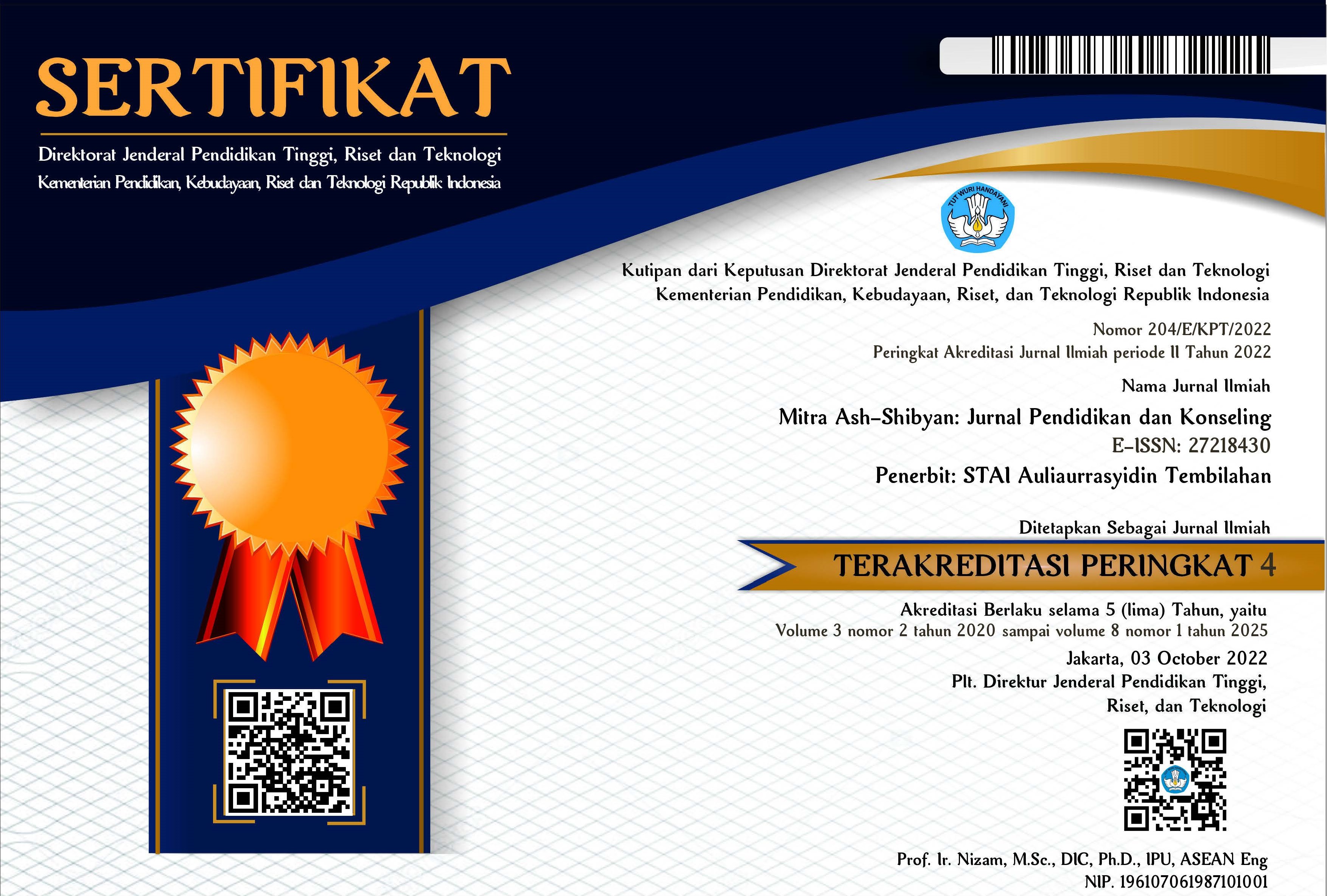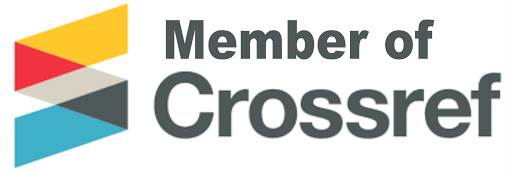Penggunaan Smartphone dan Perilaku Sosial Anak Usia Dini: A Correlational Study
DOI:
https://doi.org/10.46963/mash.v7i02.2192Keywords:
Early childhood, Social behavior, SmartphoneAbstract
A smartphone is a communication tool that has various features. Smartphone users do not only come from workers but children and toddlers. The use of smartphones, especially in early childhood, has multiple negative impacts – besides its positive impacts - such as decreased concentration while learning, causing health problems, slowing cognitive development, and affecting the formation of social behavior. In line with that, this study aims to determine the relationship between smartphone use and the formation of social behavior in early childhood. This study used a descriptive correlational design with a cross-sectional approach. The population used in this study was 108 parents, while the sample amounted to 85 parents which is taken using the purposive sampling technique. Data were collected using questionnaires about smartphone use and children’s social behavior. The data were then analyzed using the Spearmen rank correlation test with a significance of p < 0.05. The results of this study indicate that the use of smartphones is related to the formation of social behavior in early childhood, with a correlation strength value of 0.798 (correlation strength = strong).
Downloads
References
Arifin, B. (2015). Psikologi sosial - Jilid pertama, Edisi pertama. Bandung: CV. Pustaka Setia.
Aula, N. (2016). Hubungan intensitas penggunaan gadget dengan keterlambatan perkembangan pada aspek bicara dan bahasa pada balita di kelurahan tambakrejo surabaya. Skripsi: Fakultas Kedokteran Universitas Airlangga. https://repository.unair.ac.id/54134/.
Ayouby, M. H. (2017). Dampak penggunaan gadget pada anak usia dini. Skripsi. Bandar Lampung: Universitas Lampung.
Chusna, P. A. (2017). Pengaruh media gadget pada perkembangan karakter anak. Dinamika Penelitian: Media Komunikasi Penelitian Sosial Keagamaan, 17(2), 315-330. https://ejournal.uinsatu.ac.id/index.php/dinamika/article/view/842.
Fitri, N. R., dkk. (2021). Gambaran ketergantungan gadget pada anak usia sekolah. Journal JKEP. 6(2). https://ejurnal.poltekkesjakarta3.ac.id/index.php/JKep/article/view/445.
Hurlock, E.B. (1956). Child development - Fifth edition. United States of America: McGraw-Hill Book Company.
Imron Riyanti. (2017). Hubungan penggunaan gadget dengan perkembangan sosial dan emosional anak prasekolah di kabupaten lampung selatan. Jurnal Keperawatan. XIII(2), 148-154. http://ejurnal.poltekkes-tjk.ac.id/index.php/JKEP/article/view/922
Mansur, A. R. (2019). Tumbuh Kembang Anak Usia Prasekolah. Andalas University Press.
Manumpil, B., Ismanto, Y., & Onlibala, F. (2015). Hubungan penggunaan gadget dengan tingkat prestasi siswa di SMA negeri 9 manado. E-Journal Keperawatan. 1. https://ejournal.unsrat.ac.id/v3/index.php/jkp/article/view/7646
Marsal and F. Hidayati. (2017). Pengaruh smartphone terhadap pola interaksi sosial pada anak balita di lingkungan keluarga pegawas UIN Sultan Syarif Kasim Riau. Jurnal Ilmiyah Rekayasa dan Manajemen Sistem Informasi, 3(1), pp. 78–84. http://dx.doi.org/10.24014/rmsi.v3i1.3529.
Masitoh. (2014). Strategi Pembelajaran TK. Universitas Terbuka.
Nurmasari, A. (2016). Hubungan intensitas penggunaan gadget dengan keterlambatan perkembangan pada aspek bicara dan bahasa pada balita i kelurahan tambakrejo surabaya. Universitas Airlangga. https://repository.unair.ac.id/54134/
Prabowo, A. (2016). Pengaruh gadget terhadap anak dalam interaksi keluarga muslim perumahan winong kota gede yogyakarta. Jurnal Universitas Islam Negeri Sunan Kalijaga Yogyakarta. http://digilib.uin-suka.ac.id/id/eprint/23243/
Rachmawati, P. A. R. (2017). Pengaruh penggunaan gadget terhadap hasil belajar mahasiswa pendidikan biologi angkatan 2013 FKIP UNTAD pada mata kuliah desain media pembelajaran. JipBiol, 5 (1), pp. 35–40.
Salsabila, S. (2016). Pengaruh lama penggunaan gadget terhadap perkembangan anak TK al-azhar banda aceh. Syiah Kuala. 10.55382/jurnalpustakakeperawatan.v1i1.172
Simamora, A. S. M. (2016). Persepsi orangtua terhadap dampak penggunaan gadget pada anak usia pendidikan dasar di perumahan bukit kemiling permai kecamatan kemiling bandar lampung. Lampung: Universitas Lampung. https://jurnal.fkip.unila.ac.id/index.php/JKD/article/view/11569
Soetjiningsih, I.N.G.R. (2013). Tumbuh kembang anak. Jakarta: EGC.
Susanto, (2014). Perkembangan anak usia dini pengantar dalam berbagai aspeknya. Edisi pertama. Jakarta: Kencana Prenadamedia Group.
Sugiyono. (2014). Metode penelitian kuantitatif, kualitatif, dan R&D - cetakan ke-20. Bandung: Alfabeta.
Wijanarko, J., & Setiawati, E. (2016). Ayah baik-ibu baik parenting era digital: pengaruh gadget dan perilaku terhadap kemampuan anak. Jakarta Selatan: Keluarga Indonesia Bahagia.
Zaini, M., & Soenarto, S. (2019). Persepsi orangtua terhadap hadirnya era teknologi digital di kalangan anak usia dini. Jurnal Obsesi: Jurnal Pendidikan Anak Usia Dini, 3(1), 254-264. 10.31004/obsesi.v3i1.127
Zubaidah, Z. (2017). Hubungan durasi penggunaan gadget terhadap perkembangan sosial anak prasekolah di TK PGRI 33 sumurboto, banyumanik. Skripsi : Fakultas Kedokteran Universitas Ponegoro. http://eprints.undip.ac.id/55141/
Downloads
Published
Issue
Section
License
Copyright (c) 2024 Hendro Wahyudi, Niken Ayu Merna Eka Sari

This work is licensed under a Creative Commons Attribution-ShareAlike 4.0 International License.
Authors who publish with this journal agree to the following terms:
1. Copyright on any article is retained by the author(s).
2. The author grants the journal, right of first publication with the work simultaneously licensed under a Creative Commons Attribution shareAlike 4.0 International License that allows others to share the work with an acknowledgment of the work’s authorship and initial publication in this journal.
3. Authors are able to enter into separate, additional contractual arrangements for the non-exclusive distribution of the journal’s published version of the work (e.g., post it to an institutional repository or publish it in a book), with an acknowledgment of its initial publication in this journal.
4. Authors are permitted and encouraged to post their work online (e.g., in institutional repositories or on their website) prior to and during the submission process, as it can lead to productive exchanges, as well as earlier and greater citation of published work.
5. The article and any associated published material is distributed under the Creative Commons Attribution-ShareAlike 4.0 International License







2.png)



